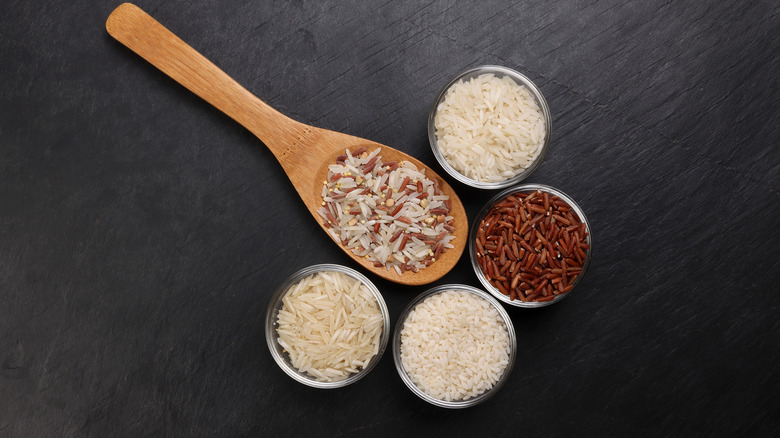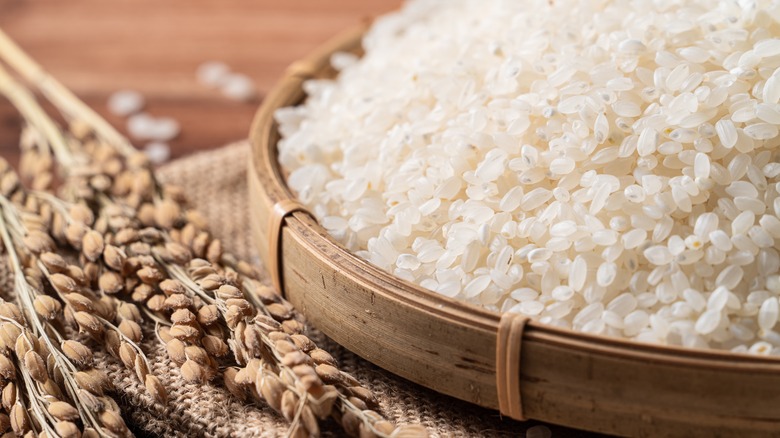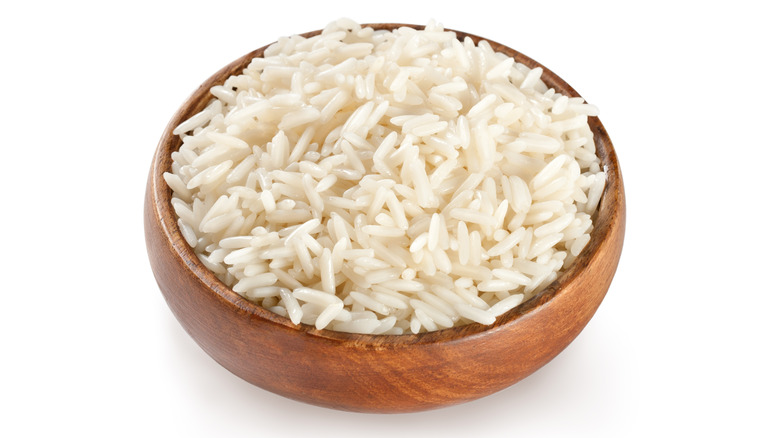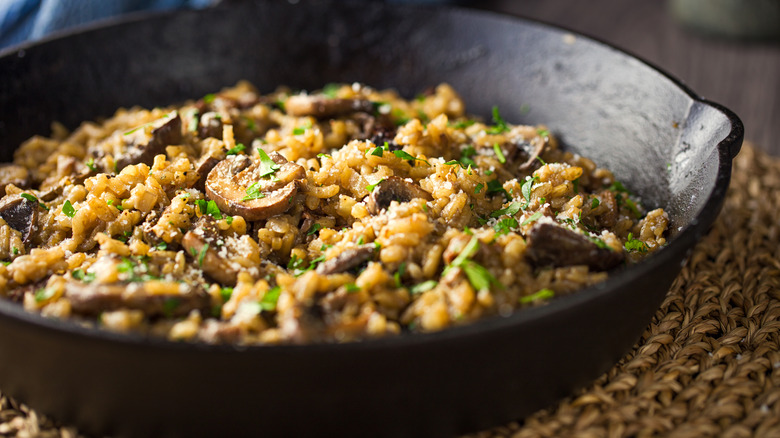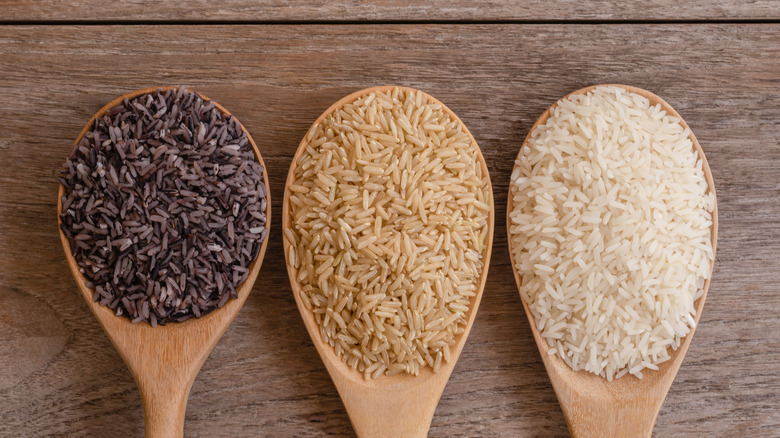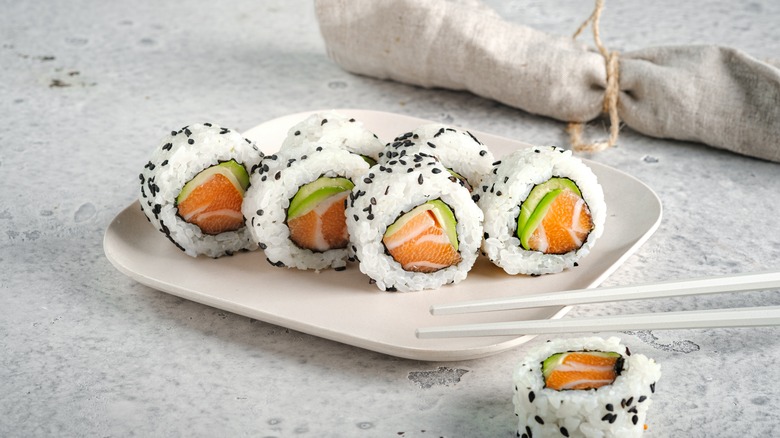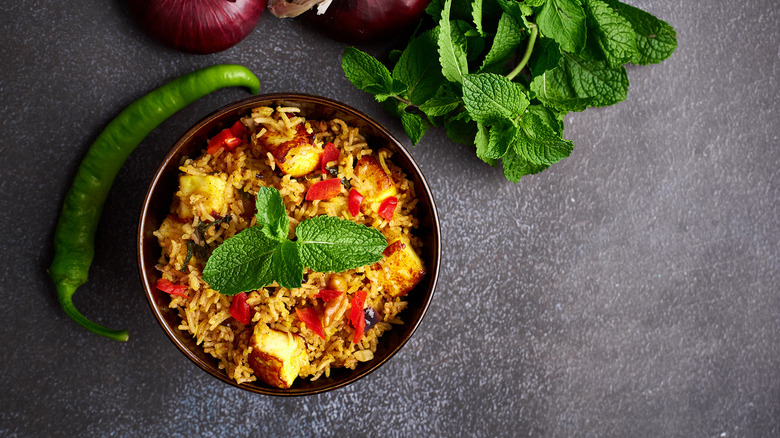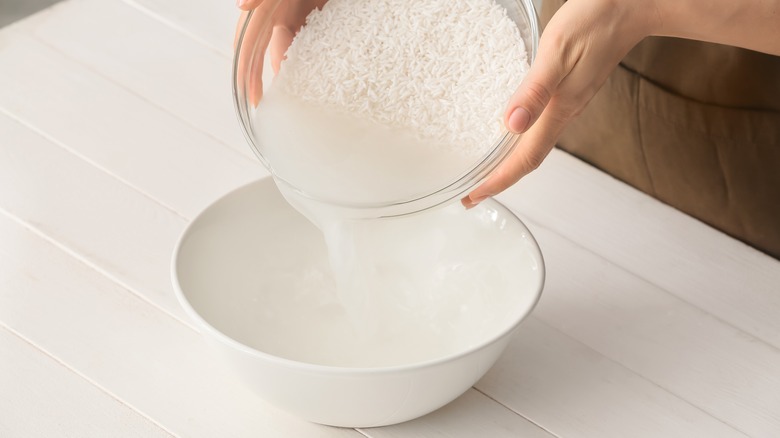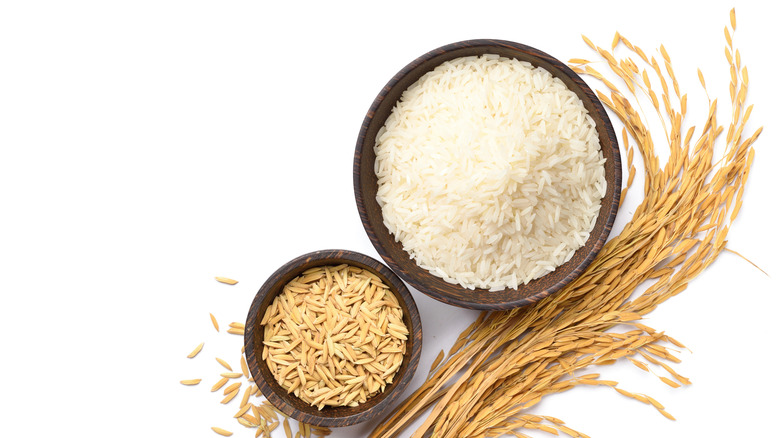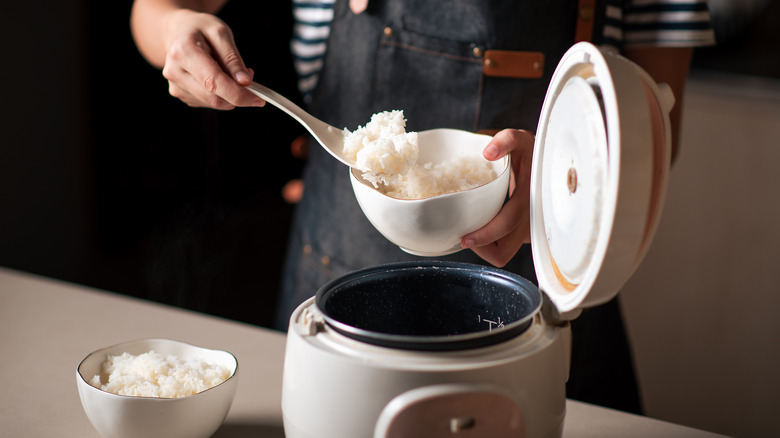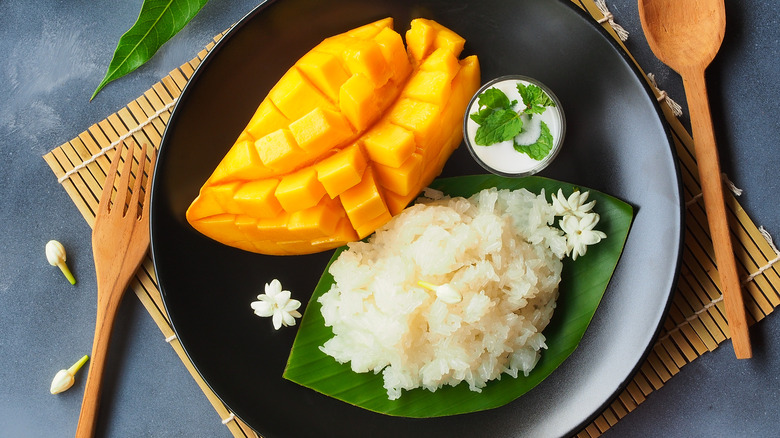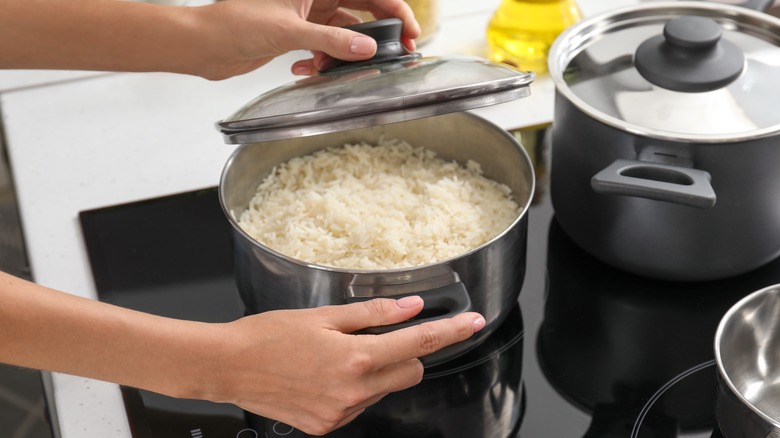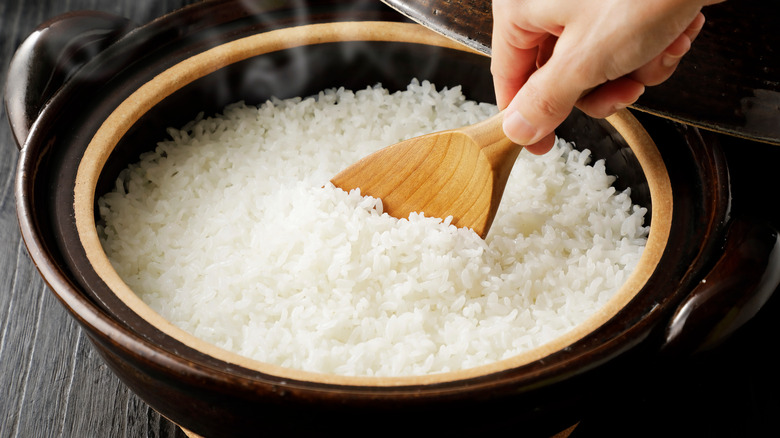Short Vs Long Grain Rice: Everything You Need To Know
Have you ever stood in front of a grocery store shelf laden with many types of rice, wondering just which one you're supposed to buy? With so many varieties available, it can seem like a challenge just shopping for dinner, let alone cooking it. Rice comes in three broad types: short grain, medium grain, and long grain. Maybe you already have a handle on medium grain varieties, but what's the deal with short grain and long grain rice and how should you use each type?
You're about to have all your questions answered as we venture into the world of short grain versus long grain rice. We'll explain the different types, how to properly cook each one, and which variety is the best for your next meal.
If you've ever been confused about the differences between short grain or long grain rice, we're here to set the record straight. Soon, you'll know exactly which type is the right one for the recipe at hand. Here's everything you need to know about short grain and long grain rice.
What is short grain rice?
Short grain rice is characterized by plump, round grains that are relatively short and wide. The grains of short grain rice tend to stick together when cooked, making them somewhat sticky and ideal for dishes that require a more compact, cohesive texture like sushi or rice pudding. It's usually not a good choice for dishes where you want distinct grains.
Because of its high starch content, short grain rice is often used in dishes that benefit from the grains sticking together, a factor that will help them to create a creamy or sticky texture. Most types of short grain rice belongs to the Japonica family, which originated in Japan. This type of rice has an especially high starch content compared to other varieties, which contributes to the aforementioned sticky or creamy consistency. However, not all are made the same. Some varieties of short grain rice belong to the lower-starch Indica family, which originated in India. These types of rice are far less sticky, so they shouldn't be used interchangeably with Japonica varieties.
What is long grain rice?
Long grain rice is a type of rice that is known for its long, slender grains that tend to remain separate after cooking. The grains in the long grain Indica variety are generally four to five times longer than they are wide and have less starch than short grain rice. This lower starch content helps to give long grain rice its characteristic fluffy texture after it's been cooked. Long grain rice also doesn't clump together as much as short grain rice when cooked, making it a popular choice for dishes where you want a more distinct grain structure.
While most short grain rice belongs to the starch-heavy Japonica family, most long grain varieties belong to the Indica family. That said, you can find some starchier Japonica long grain rice, so make sure you pay attention to the variety you're buying.
Generally speaking, long grain rice is valued for its individual, non-sticky grains and versatility in many types of dishes, where it can provide a light and fluffy texture that contrasts with the stickier texture of short grain rice.
Types of short grain rice
There are many varieties of short grain rice, each with unique characteristics and culinary uses. Arborio rice is an Italian short grain variety often used to make creamy risotto. It has a high starch content that, when cooked, creates a creamy texture that's perfect for absorbing the flavors of broth and other ingredients. Similar to arborio, carnaroli rice is another Italian variety that can also be used in risotto. It's known for its ability to absorb a lot of liquid without overcooking, resulting in a creamy dish yet with a slightly firm texture.
Bomba rice is a Spanish short grain variety that is traditionally used in paella. It has the ability to absorb large amounts of liquid while maintaining individual grains, making it perfect for flavorful and visually appealing paella. Calasparra is another Spanish short grain that stands up well in paella and other dishes where you don't want the rice to stick together.
Glutinous or sticky rice is commonly used in Asian cuisine, especially in dishes that require a sticky texture. Meanwhile, short grain sushi rice is specifically meant for making sushi. It's traditionally seasoned with rice vinegar, sugar, and salt to achieve the characteristic flavor and sticky texture needed for a perfect sushi roll.
Types of long grain rice
If you think there's just one type of long grain rice, you're sorely mistaken. There are many strains, but these are some of the most common. Fragrant basmati rice is primarily grown in India and has a nutty flavor and distinct floral aroma. India also produces patna and sona masoori rice, both of which are often used in everyday cooking and have varying levels of aroma and stickiness.
Jasmine rice is another variety of fragrant long grain rice (although it's occasionally classed as medium grain) that is commonly found in Southeast Asian cuisines, particularly in Thai cooking. It has a subtle floral aroma and a slightly sticky texture that helps it hold together in dishes. Thai hom mali rice is a premium jasmine rice variety from Thailand, known for its fragrance and soft texture.
American long grain rice varieties, such as Carolina Gold and toro rice, are commonly grown in the southern United States. They have a neutral flavor and tend to stay separate when cooked. Wehani rice is an aromatic long grain variety that has a reddish-brown color and nutty flavor. It's often used in dishes such as pilafs and rice salads. True to its name, red rice also has a reddish-brown color and a slightly nutty flavor and chewy texture.
What can you make with short grain rice?
If you want to experiment with short grain rice, what should you make to use it best? Luckily, there are plenty of options. Just make sure you use the right strain of short grain rice for the recipe you want to make.
Short grain varieties are a staple in sushi due to their sticky nature, which helps hold the rice and other ingredients together in sushi rolls and nigiri. In Japanese cuisine, short grain rice is also used to make onigiri, rice balls filled with ingredients like vegetables, pickled plum, or fish and wrapped in nori.
Short grain rice varieties like arborio and carnaroli are used to make creamy, flavorful risotto, where the rice is slowly cooked and stirred with broth until it reaches a perfectly creamy consistency. Short grain rice is also used to make arancini, Italian rice balls that are coated in breadcrumbs and fried.
Paella, a traditional Spanish dish, is often made using short grain varieties like Bomba rice. The rice is cooked with saffron and proteins and vegetables, creating a colorful and flavorful one-pan meal. The creamy texture of short grain rice is also perfect for making comforting rice pudding, often flavored with cinnamon, vanilla, and raisins. In some places, you can buy pudding rice meant specifically for rice pudding, but otherwise any starchy short grain rice will do.
What can you make with long grain rice?
You can use versatile long grain rice to whip up many different dishes. Serve it as a side dish to accompany a main course, such as a curry or stir fry. Or create flavorful pilafs by sautéing long grain rice with onions and garlic, then cooking it with broth or stock and adding ingredients like vegetables, spices, herbs, nuts, or dried fruits.
You can make delicious fried rice by using day-old cooked long grain rice and stir-frying it with vegetables, proteins, eggs or tofu, and sauce. Long grain rice is also commonly used to make biryani, a fragrant Indian rice dish. This type of rice pairs well with beans to create simple yet hearty and nutritious dishes such as red beans and rice.
Cajun and Creole jambalaya combines long grain rice with proteins, vegetables, tomatoes, and spices. You can also cook up rice salads by mixing cooked long grain rice with fresh vegetables, herbs, and a tangy dressing.
Starch levels of rice varieties
The starch levels of different types of rice can significantly impact texture, flavor, and culinary applications. Starch determines how rice grains behave when cooked, affecting factors such as stickiness, fluffiness, creaminess, and the absorption of flavors.
Rice varieties with higher starch content — such as most forms of short grain rice — tend to be stickier and have a more cohesive texture. Varieties with lower starch, like most long grain rice, remain more separate and fluffy.
Rice varieties with more starch can become creamy when cooked, making them ideal for dishes like risotto, where the rice grains release starch and create a luxurious texture. High-starch rice can also absorb flavors more effectively, making it great for dishes where you want the rice to take on the taste of other ingredients.
Although most short grain rice is high in starch, there are some exceptions, such as bomba rice used in paella. Likewise, most long grain rice is lower in starch with a few notable exceptions, such as Carolina Gold. Generally, the variety will dictate the starch level, rather than grain length.
White vs brown rice
Both short grain and long grain rice come in white and brown varieties, but what's the difference and which should you buy? Brown rice is a whole grain rice that retains its outer bran layer, which contains fiber, vitamins, and minerals. Only the inedible outer husk is removed. This gives brown rice its nutty flavor, chewy texture, and namesake brown color. White rice has had both the bran and the germ removed in a process that also removes most of the fiber and nutrients, resulting in a milder taste, softer texture, and white color.
Per Healthline, brown rice is considered more nutritious than white rice because it retains the bran and germ around the grain's carby endosperm. Brown rice is a good source of dietary fiber, B vitamins, and minerals like magnesium and phosphorus. White rice contains fewer vitamins, minerals, and fiber due to the removal of the bran and germ during processing. Brown rice has a lower glycemic index, too, which means it causes a slower and steadier increase in blood sugar levels after you eat it, compared to more processed white rice.
As for cooking, brown rice typically requires a longer cooking time and more water due to its intact bran layer. It is relatively chewy and has a slightly nuttier flavor. White rice cooks faster and has a softer, fluffier texture.
Should you use short grain or long grain rice?
Once you know when to use short or long grain rice, trips to the grocery store will become less fraught. Since short grain rice is generally starch-heavy, you should use it when you need a stickier and more cohesive texture. If you're making dishes like sushi, rice balls, or rice puddings where a sticky consistency is important, short grain rice is a better choice. It's also suitable for dishes like risotto and rice puddings that require a creamy consistency.
Because long grain rice generally remains separate and fluffy when cooked, it's ideal for dishes where individual grains are preferred, such as pilafs, fried rice, and curries. Aromatic long grain rice varieties like basmati or jasmine add a pleasant fragrance to dishes like biryani and pilaf. It's also good for dishes with flavorful sauces, as the grains won't stick together excessively and therefore allow the sauce to be absorbed without losing the overall texture of the dish.
Can you substitute short grain for long grain rice?
Substituting short grain rice for long grain rice, or vice versa, is possible in some recipes. However, it generally isn't a great idea because the two types often behave very differently. That's why it's important to carefully consider the differences in texture and cooking properties between the two types of rice before you start switching things up.
Short grain rice is stickier and has a softer, more chewy texture. If you substitute long grain rice for it in a dish that relies on stickiness, it likely just won't hold together as it should, leaving you with a sushi roll that crumbles. If you're making a dish that requires creaminess, substituting a relatively lower starch long grain variety may result in a less satisfying consistency. However, there are some types of long grain rice that are relatively sticky and which can make acceptable substitutions for short grain varieties, so pay close attention to the variety and you may get by.
If you use short grain rice in a dish that should have distinct, separate grains, like a pilaf, the texture will likely be too thick. If you must use short grain rice in place of long grain, it should be a variety that isn't too starchy so you can keep its grains separate when cooked, such as bomba or calasparra.
How to cook short grain rice
It's easy to make mistakes when cooking rice. Moreover, cooking short grain rice, whether it's white or brown, involves slightly different steps compared to long grain rice, mostly due to its stickier nature. However, paying attention should keep you on the right track, starting with how you prep your rice. To cook short grain white rice, first rinse it under cold water until the water runs clear. This helps remove excess starch and prevents the rice from becoming too sticky. For every cup of short grain white rice, use 1¼ to 1 ½ cups of water, depending on your desired texture. In a pot, combine the rinsed rice and water. Let it soak for 20 to 30 minutes if time allows.
Place the pot on the stove over medium-high heat and bring the rice and water to a boil. Once boiling, reduce the heat to low, cover with a lid, and simmer for about 10 minutes. Avoid peeking while the rice is cooking. Once it's done cooking, remove the pot from the heat and let it sit, covered, for another 10 minutes. This allows the steam to finish cooking the rice. Use a fork to gently fluff the rice and serve.
To cook short grain brown rice, the method is similar, except you will use 2 cups of water for every cup of rice. The cooking time is also longer — it needs about 45 minutes to cook, plus 10 minutes off the heat.
How to cook long grain rice
Cooking long grain rice is slightly different from cooking short grain rice. You start in the same way by rinsing your rice under cold water until the water runs clear. This also helps to remove excess starch and improves its fluffy texture. For every cup of long grain white rice, use 1 ½ to 2 cups water (1 ½ cups for slightly firmer rice, 2 cups for softer rice). For long grain brown rice, you need 2 to 2 ½ cups of water per cup of rice.
Combine the rinsed rice and water in a pot. Cook the rice on the stove over medium-high heat until the water comes to a boil. Then, reduce the heat to low, cover the pot with its lid, and let the rice cook. Simmer white rice for 15 to 20 minutes and brown rice for about 45 minutes. Avoid stirring the rice while it's cooking. Once time is up, remove the pan from the heat, leaving the lid on. Let it sit for 5 to 10 minutes before removing the lid and fluffing the rice with a fork.
